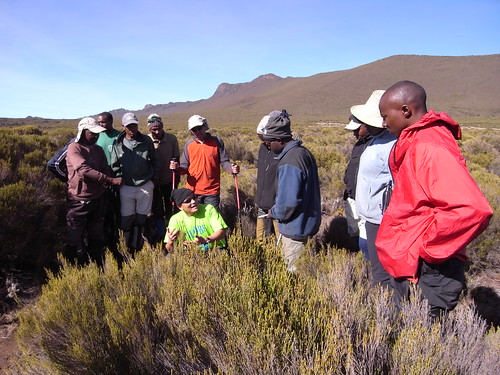Today the team will hike from Shira 1 Camp to Moir Hut (Shira 2 Camp on the map below). This part of the journey will take the team further into the heath zone. As discussed yesterday, the heath zone is a zone of sparse vegetation due to lower rainfall amounts.

The route the team is taking: the western approach route

The team stops for a discussion about soils
Today’s question focuses on the protocols that the team is collecting along the journey. The question is: You will be collecting data using GLOBE protocols. Which measurements are you most excited to monitor through the trek? Are there other data you would have liked to collect during the trek? If so, what additional equipment or materials would you have needed in order to perform these measurements?
Maddy
I’m most excited to work with the water and ice… something about it has always enticed me. In school in Colorado I’ve done many experiments looking at pollution levels and temperatures of streams, but this will be my first time working with glaciers. I’m also fascinated by the life at altitude on the mountain and how they deal with decreasing amounts of oxygen.
Bob
The only GLOBE protocol I will be collecting is soil moisture content, color and texture. In each biome and stream that we encounter, I will also be collecting additional measurements of stream flow, stream conductivity, stream temperature, and water samples for isotopic composition. Each of these measurements only provide a snapshot of the ecosystem. Ideally, I would like to collect each of these measurements – especially stream flow and soil moisture and additionally precipitation – over a one year period in order to capture seasonal variations of the water balance.
John
Having spent most of my own in the Arctic and the Antarctic, I am very interested in learning about the permafrost and the glaciers at the top of Kilimanjaro. I am looking forward to talking with the scientists on the trip about how and when this area formed and how it has changed to the state that it is in today. I also want to look at the data and the projections on how this biome will change over the next few decades and what changes to the organisms it will have.
I would have liked to measure the CO2 changes at each biome to help better understand what is happening with the photosynthesis as well as the respiration activity in the soils at each level. We would need a gas analyzer and some chambers to take these measurements. I would expect to see different amounts of change at each of the biome layers, including some of the plant species moving into new layers.

Dr. Lonnie Thompson, a glaciologist at Ohio State University, emphasized that the melting of ice atop Mount Kilimanjaro was paralleled by retreats in ice fields elsewhere in Africa as well as in South America, Indonesia and the Himalayas. NASA recently reported the same on the Arctic Sea Ice. Are we in the middle of a global decline in moisture levels?
Yes Maria, I guess…